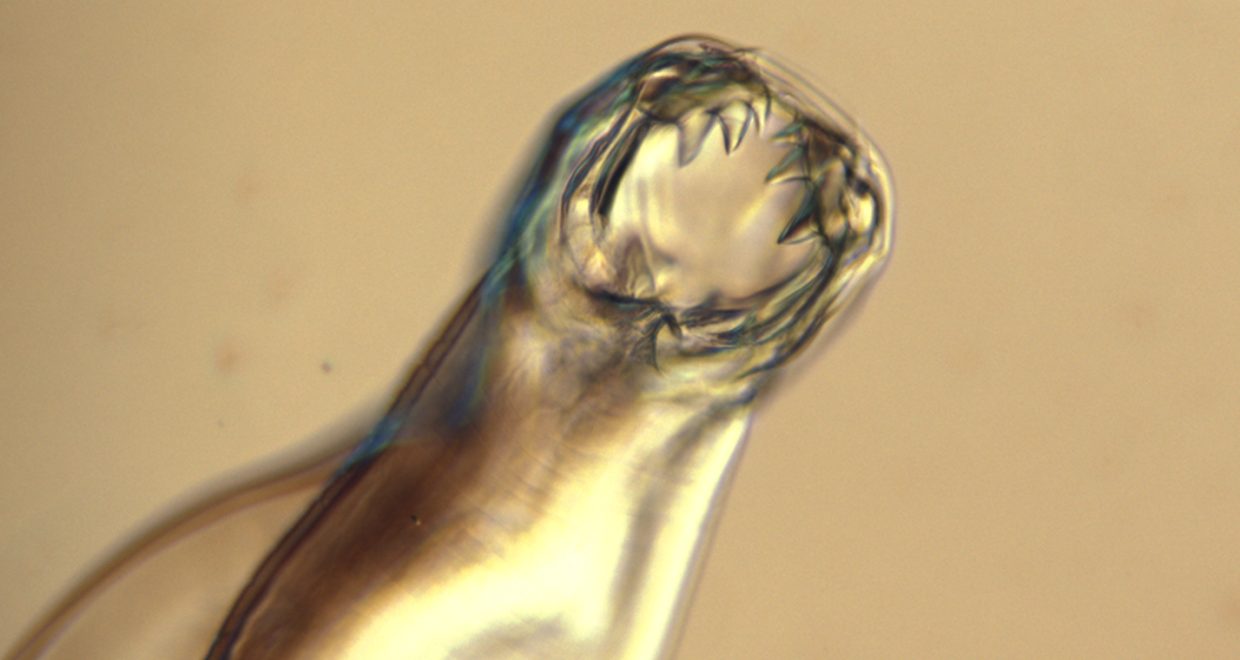Comparative transcriptomics from intestinal cells of permissive and non-permissive hosts during Ancylostoma ceylanicum infection reveals unique signatures of protection and host specificity
The latest Paper of the Month for Parasitology is Comparative transcriptomics from intestinal cells of permissive and non-permissive hosts during Ancylostoma ceylanicum infection reveals unique signatures of protection and host specificity and is freely available.
Hookworms place a tremendous burden on health and economics worldwide, with an estimated 450 million people infected. Children and pregnant women carry the heaviest pathological burden, and blood feeding by the worm in the intestine can cause anemia and delays in physical and intellectual development. Anthelmintic drugs are currently used to treat hookworms, but the emergence of drug resistance is a growing concern. Also, there are challenges associated with development of vaccines against hookworms, due to the complex life cycles and immunomodulatory properties of these parasites. Hookworms produce a range of molecules that can suppress or evade immune responses, and the immune response varies depending on factors such as age, nutritional status, and prior exposure.
How do hookworms choose their hosts? Well, it turns out that they are pretty picky eaters. For them to successfully colonize a host, they need to find one in which they can grow and reproduce. But what exactly makes a host permissive? Basically, a permissive host is one that can’t produce an immune response to fight off the parasites. It’s as if the parasites are annoying house guests who just won’t leave – they only stay if you’re not strong enough to kick them out! On the other hand, a non-permissive host is like a host who has a strong security system – they can detect the parasites and stop them from developing, or even expel them from their body altogether. Also, parasites can be picky about their hosts – some hookworm species will only infect closely related hosts, while others will infect anything from dogs and cats to hamsters and humans. Hence, we wanted to utilize the hookworm genus Ancylostoma to investigate specificity mechanisms, as they range from strict specialists to generalists. The aim of our study was to utilize permissive and non-permissive hosts to identify differentially expressed genes (DEGs) in response to infection with A. ceylanicum infective third stage larvae (L3).We hypothesized that a non-permissive host mounts an early immune response to invasion, or to excretory/secretory products (ESPs) produced by the L3, that protects against infection. The permissive host is unable to generate the protective response. Another possibility is that the permissive hamster host provides a positive signal to the parasite in response to invasion or larval stage ES products that initiates development.

To test our hypothesis, we performed enrichment analysis on the DEGs across early time points in the infection to identify functional responses to hookworm infection. We have identified candidate DEGs that provide novel insight into the molecular determinants of host specificity by recognizing the differences in activated signals and pathways between permissive and non-permissive hosts. Overall, an increased activity of the immune system in the non-permissive mice, but not permissive hamsters, was found. The lack of a significant protective response in hamsters is likely because of modulating ES products released by A. ceylanicum. Further research is needed to identify the ESPs released by L3s into the different host environments to advance the understanding of the crosstalk between hookworm L3s and their host.
The paper Comparative transcriptomics from intestinal cells of permissive and non-permissive hosts during Ancylostoma ceylanicum infection reveals unique signatures of protection and host specificity by Andrea Langeland, Emilia Grill, Amol C. Shetty, Damien M. O’Halloran, and John M. Hawdon, published in Parasitology, is freely available.






